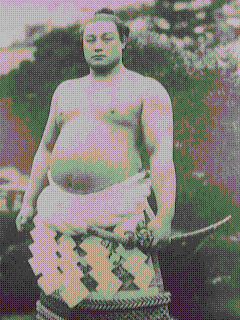

"Hara wo Nakushita Nihonjin" written by Dr. Hideo Takaoka.
1. Shift yourself from the opponent's center
The fight in Kendo is often described as the struggle for the center. However, while trying to dominate the center, players often let their centers face with each other. Under such a circumstance, the Seme will be quite linear and the outcome of the match will simply depend on power and speed. Please take a look at the following picture. This is taken from "Hara wo Nakushita Nihonjin" written by Dr. Hideo Takaoka. Dr. Takaoka is explaining the difference between the Sumo in the past and the Sumo in our time with this picture. According to his theory, the Sumo now is just like a fight between the ends of pencils, while the one in the past was more like a fight between the tips. In the former case, a match will be fought over power and speed by pushing each other. On the other hand, in the latter case, it represents the technique which cancels out the force of the opponent by shifting oneself from the center of the opponent. When I saw this picture, I thought that this is applicable to Kendo as well. Modern Kendo is just like jumping from a distance and is pretty much the same as the former example. Please take time to imagine the Kendo as in the latter example. I think that, while paying attention to taking control of the center, we have become pretty careless about the technique to shift the center, because, unlike in Sumo or in Judo, we do not grapple with each other. If you can shift your body from the center of the opponent, even if he/she jumps from a distance like a missile with a full power and at a full speed, the opponent will end up with just passing by without touching you, while you can reach him/her with only the minimum required power and speed, since you are facing towards the center of the opponent.
"Hara wo Nakushita Nihonjin" written by Dr. Hideo Takaoka.

2. Be a Bushi
I will tell you an interesting story. In the Kendo rules and regulations, there is an article about the penalty for dropping Shinai (Shinai-Hanashi). Although this penalty seems to be rarely pronounced these days, according to the rules and regulation, Hansoku-Ikkai will be sentenced to the player who committed this conduct. I have once heard that, upon making such a rule, one Sensei said that it should be considered as Ippon rather than Hansoku-Ikkai, since dropping the sword means to die in the real battle. Many Sensei first agreed with his opinion and asked an opinion of Chutaro Ogawa Sensei. Then, Ogawa Sensei, without hesitation, replied "it's Bushi no Nasake (the mercy of the Bushi)". What do you think about his opinion? According to the rules and regulations, a stroke made right after the opponent drops his/her Shinai is considered valid. However, after reading this story, can you still hit an opponent who does not have a Shinai? Shouldn't we instead keep the opponent in check and wait until he/she takes the Shinai back, rather than try hitting as if it were the best chance to win? Isn't a real Bushi supposed to be like that?
Please think a bit more about this. If the Shinai which you now hold is the real sword, what kind of Kendo would you play? Are you going to kill the opponent when you see an unguarded moment? If so, then, you will be a mere murderer.
I think that these kinds of questions are pretty philosophical, and you may wonder what the correct answer is. At the same time, the answer can vary depending on your perspective of Kendo and how you are facing with it. However, it's not such a bad idea to practice Kendo all one's life by looking for the answer, isn't it???
written by Ryoichi Shimano
translated by Hiroyuki Otaki (Shidokan Kendo Club)
shimano Mail: shimano@st.rim.or.jp